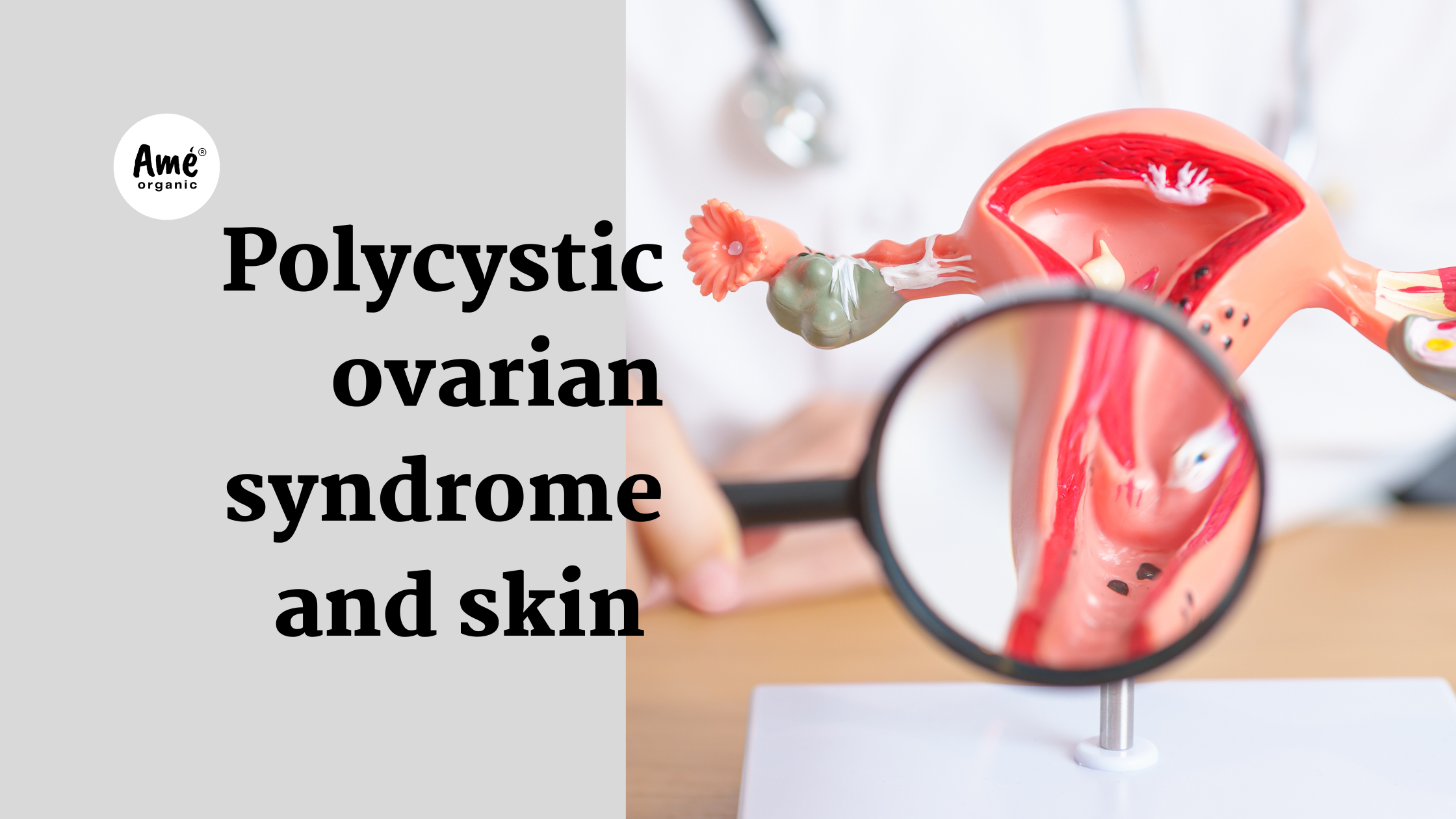Polycystic Ovary Syndrome (PCOS) is a complex endocrine disorder that exerts significant effects on various organ systems, including the skin. The dermatological manifestations of PCOS, such as acne, hirsutism, seborrhea, and acanthosis nigricans, are primarily driven by the hormonal imbalances intrinsic to the condition, particularly hyperandrogenism and insulin resistance. This article provides a detailed exploration of the molecular and cellular mechanisms linking PCOS to skin health.
What is PCOS?
Polycystic Ovary Syndrome (PCOS) is a complex endocrine disorder characterized by hyperandrogenism, ovulatory dysfunction, and the presence of polycystic ovarian morphology. It involves disrupted steroidogenesis and insulin resistance, leading to a range of metabolic and reproductive abnormalities. PCOS is a leading cause of infertility and is associated with an increased risk of metabolic syndrome, type 2 diabetes, and cardiovascular disease.
-
Hyperandrogenism: The Central Role of Androgens in Skin Pathology
Hyperandrogenism is a key feature of PCOS and plays a central role in the development of skin disorders. Androgens, including testosterone, dihydrotestosterone (DHT), and androstenedione, are involved in regulating various skin functions, including sebaceous gland activity, hair growth, and keratinocyte proliferation.
a. Sebaceous Gland Activity and Acne Formation
- Androgen Receptors (ARs): Sebaceous glands are rich in androgen receptors (ARs). When androgens bind to these receptors, they activate a signalling cascade that stimulates the production of sebum, an oily substance that lubricates and protects the skin. However, in PCOS, excessive androgen levels lead to hyperactivation of these glands, resulting in increased sebum production.
- Sebum and Acne Pathogenesis: The overproduction of sebum creates an environment conducive to the growth of Propionibacterium acnes (P. acnes), a bacterium that colonizes hair follicles. The combination of sebum, keratinocytes, and bacterial proliferation leads to the formation of comedones (blackheads and whiteheads). Inflammatory mediators released by P. acnes contribute to the development of inflammatory acne lesions, including papules, pustules, and cysts.
b. Hair Follicle Dynamics and Hirsutism
- Androgen-Induced Terminal Hair Growth: Androgens influence hair follicle dynamics by promoting the transformation of fine vellus hairs into thick, pigmented terminal hairs. This effect is mediated through the upregulation of genes involved in hair follicle development, including those encoding enzymes like 5α-reductase, which converts testosterone into the more potent DHT.
- Regional Sensitivity: The distribution of hirsutism in PCOS follows a male-pattern hair growth, affecting areas such as the face, chest, and back. This pattern is due to regional variations in androgen receptor density and sensitivity, with certain areas of the skin being more responsive to androgenic stimulation.
-
Insulin Resistance: Amplifying Androgenic Effects and Skin Disorders
Insulin resistance is another hallmark of PCOS that significantly influences skin health. Elevated insulin levels, or hyperinsulinemia, exacerbate hyperandrogenism and contribute to other skin conditions.
a. Insulin's Role in Androgen Production
- Ovarian Androgen Synthesis: Insulin directly stimulates ovarian theca cells to produce more androgens by upregulating the expression of enzymes involved in androgen biosynthesis, such as cytochrome P450c17. This leads to an increase in circulating androgen levels, which, in turn, affect skin health.
- Reduced SHBG Levels: Insulin also decreases the hepatic production of sex hormone-binding globulin (SHBG), a protein that binds to androgens in the blood. Lower SHBG levels result in higher concentrations of free (bioavailable) testosterone, further exacerbating hyperandrogenism.
- Insulin and Keratinocyte Proliferation: Acanthosis nigricans, characterized by hyperpigmented, velvety plaques, is a direct result of insulin's mitogenic effects on skin cells. Insulin acts through the insulin-like growth factor-1 (IGF-1) receptor pathway, promoting the proliferation of keratinocytes and dermal fibroblasts. This leads to the thickening and darkening of the skin, particularly in areas such as the neck, armpits, and groin.
-
Inflammatory Pathways: The Role of Chronic Low-Grade Inflammation
PCOS is associated with chronic low-grade inflammation, which contributes to the exacerbation of skin conditions.
a. Cytokine-Mediated Inflammation in Acne
- Pro-Inflammatory Cytokines: Elevated levels of pro-inflammatory cytokines, such as tumor necrosis factor-alpha (TNF-α), interleukin-6 (IL-6), and interleukin-1β (IL-1β), are commonly observed in women with PCOS. These cytokines can induce the expression of inflammatory markers in sebaceous glands, promoting the development and persistence of acne lesions.
- NF-κB Pathway Activation: The nuclear factor kappa-light-chain-enhancer of activated B cells (NF-κB) pathway is a key regulator of inflammation and is activated in response to elevated cytokine levels. Activation of NF-κB in sebaceous glands and hair follicles enhances the production of inflammatory mediators, perpetuating the inflammatory process in acne.
-
Dysregulation of Lipid Metabolism in the Skin
PCOS-related hyperandrogenism also affects lipid metabolism within the skin, contributing to conditions such as seborrhea and exacerbating acne.
a. Altered Sebum Composition
- Lipid Synthesis: Androgens influence the synthesis of lipids within sebaceous glands, altering the composition of sebum. An increase in lipid production can lead to an imbalance in the skin’s natural barrier, making it more susceptible to colonization by acne-causing bacteria and promoting inflammation.
- Seborrhea Development: The overproduction of sebum, coupled with the altered lipid profile, leads to seborrhea, characterized by oily skin and greasy scales. This condition is commonly associated with the exacerbation of acne and can contribute to a cycle of inflammation and skin barrier dysfunction.
-
Genetic and Epigenetic Factors
Recent studies have highlighted the role of genetic and epigenetic factors in the skin manifestations of PCOS. Variants in genes related to androgen metabolism, insulin signalling, and inflammatory pathways may predispose individuals to more severe dermatological symptoms.
a. Gene Expression Modulation
- Epigenetic Modifications: Epigenetic changes, such as DNA methylation and histone modifications, can alter the expression of genes involved in skin health. These changes may be driven by environmental factors, such as diet and lifestyle, which are often altered in women with PCOS.
Conclusion
The impact of PCOS on skin health is a result of a complex interplay between hyperandrogenism, insulin resistance, chronic inflammation, and genetic predisposition. Understanding these mechanisms provides valuable insights into the development of targeted therapies for the skin conditions associated with PCOS. By addressing the root causes of these manifestations, such as hormonal imbalances and insulin resistance, it is possible to improve both the dermatological and overall health outcomes for women with PCOS.

